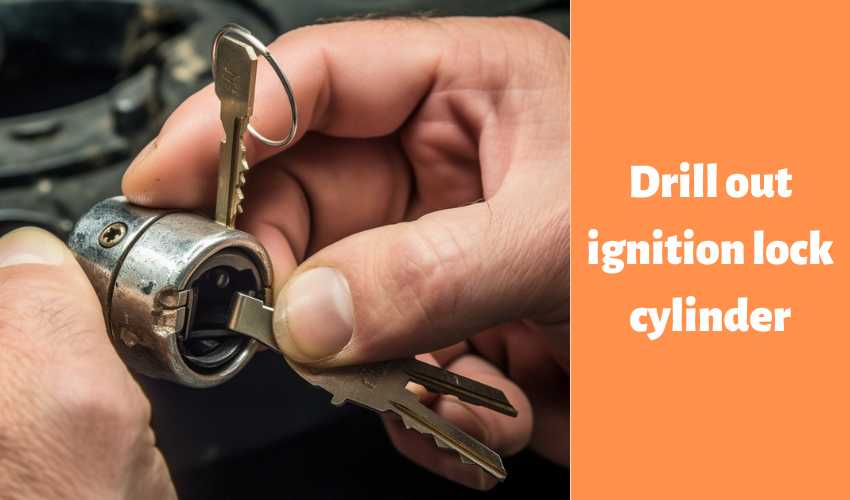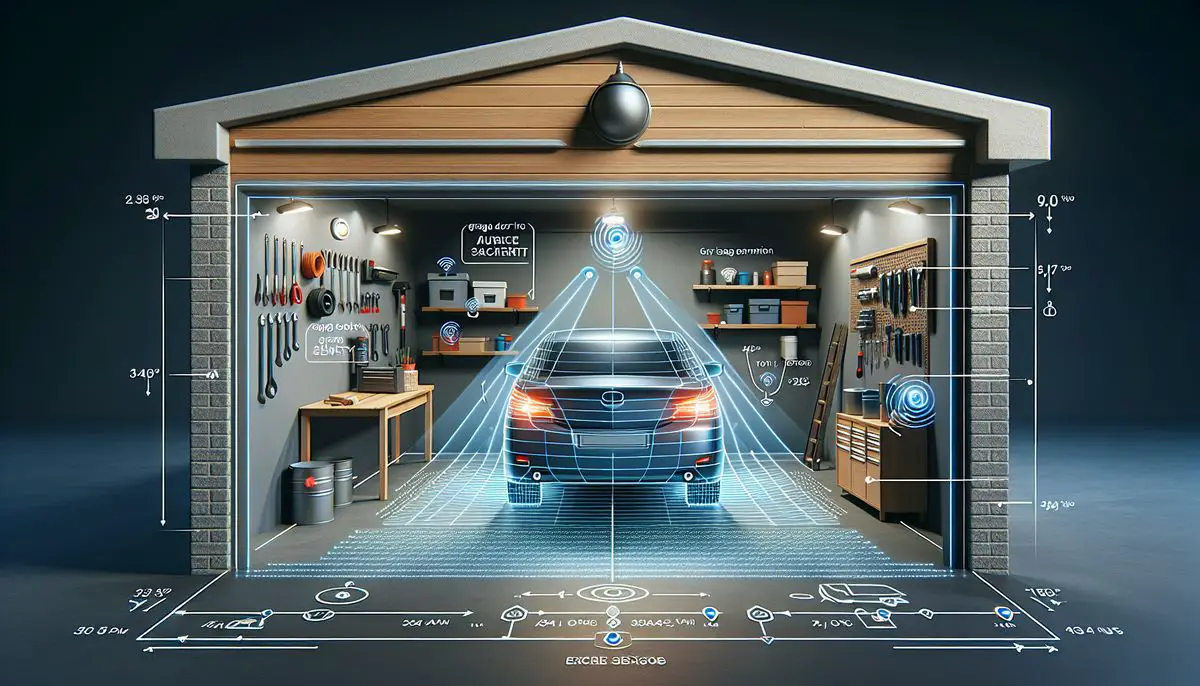Drilling out an ignition lock cylinder is a crucial skill for vehicle owners facing a malfunctioning or jammed ignition system. This procedure, often seen as a last resort, can be necessary in various situations:
- Lost or Broken Keys: When keys are lost or broken, accessing the ignition system becomes a challenge. Drilling out the cylinder provides a way to start the vehicle in emergencies.
- Wear and Tear: Over time, the ignition lock cylinder can wear out, making it difficult to turn the key. Drilling may be the only option if the cylinder is beyond repair.
- Attempted Theft or Vandalism: After an attempted theft or vandalism, the ignition lock might be damaged, necessitating drilling for removal and replacement.
It’s essential to understand that drilling out an ignition lock cylinder should only be done when other methods have failed. This process is intricate and requires a careful approach to avoid further damage to the vehicle. Additionally, it’s crucial to be aware of the legal implications; drilling should only be performed on vehicles you own or have explicit permission to work on. Safety is paramount during this task to prevent injuries and damage to the vehicle’s electrical system.
For more detailed information on the procedure and safety measures, consulting authoritative sources like automotive repair manuals or educational websites is advisable. These resources provide in-depth guidance on automotive repair tasks, ensuring you’re well-informed and prepared for the job.
More: How to Drill a Hole in Cast Iron: Steps and Tips for Drilling Into This Tough Metal
Understanding the Ignition Lock Cylinder
The ignition lock cylinder is a pivotal component in a vehicle’s ignition system. Here’s a breakdown of what it is and its role:
- Primary Function: It serves as a security gatekeeper and a switch for starting the vehicle. When you insert and turn the key, it activates the ignition system and starts the engine. Drilling out the ignition lock cylinder becomes necessary when the key mechanism fails.
- Security Feature: It’s uniquely designed for each vehicle, adding a layer of security. The cylinder must match the key’s pattern to allow the engine to start, preventing unauthorized use.
- Mechanical and Electrical Roles:
- Mechanically, it holds the ignition switch in place.
- Electrically, it connects the battery to the starter motor and ignition system when the key is turned.
- Wear and Tear: Over time, the ignition lock cylinder can wear out, leading to difficulties in turning the key or even failure to start the car.
- Types of Ignition Lock Cylinders: There are various types, each suited to different vehicle models. Some are integrated with electronic components, adding complexity to their operation and repair.
Tools and Materials Needed
To successfully drill out an ignition lock cylinder, specific tools and materials are essential for the task. Here’s a list of the required items and their purposes:
- Power Drill: The primary tool for drilling. Choose a reliable and sturdy drill capable of handling metal surfaces.
- Drill Bits: High-quality drill bits specifically designed for metal drilling. A set of varying sizes ensures you have the right bit for different stages of drilling.
- Safety Equipment:
- Safety Glasses: To protect your eyes from metal shavings and debris.
- Gloves: Durable gloves to safeguard your hands during the process.
- Lubricant: A lubricant like WD-40 helps in reducing friction and heat generated during drilling.
- Vise Grips or Clamps: These tools secure the lock cylinder in place, preventing movement while drilling.
- Punch Tool: A punch tool helps in marking the spot on the ignition cylinder where you’ll start drilling.
Each of these tools plays a vital role in the process of drilling out an ignition lock cylinder. The drill and drill bits are the central elements responsible for penetrating the cylinder. Safety equipment is crucial to prevent injuries, while lubricant and securing tools like vise grips ensure a smoother and more controlled operation.
Preparing to Drill Out the Ignition Lock Cylinder
Before you begin the process to drill out an ignition lock cylinder, it’s crucial to properly prepare both the vehicle and the work area. Here’s a comprehensive guide on how to do so, along with essential safety precautions:
- Vehicle Preparation:
- Disconnect the Battery: Ensure the vehicle’s battery is disconnected to prevent any electrical short circuits or accidental engine start.
- Steering Wheel Position: Adjust the steering wheel to a comfortable position, allowing clear access to the ignition lock cylinder.
- Remove Obstructions: Clear away any components obstructing access to the ignition cylinder. This may include steering column covers or dashboard panels.
- Work Area Setup:
- Well-Lit Environment: Ensure your work area is well-lit, providing clear visibility while you work.
- Organize Tools: Have all necessary tools within easy reach. This organization reduces the risk of distractions or accidents.
- Stable Work Surface: If the ignition cylinder is removed from the vehicle for drilling, use a stable work surface to secure it.
- Safety Precautions:
- Wear Safety Gear: Always wear safety glasses and gloves. This protects you from metal shavings and sharp edges.
- Check Drilling Equipment: Ensure your drill and drill bits are in good condition and suitable for metal drilling.
- Ventilation: Work in a well-ventilated area to avoid inhalation of metal particles or fumes from lubricants.
- Legal and Ethical Considerations:
- Ownership Verification: Confirm that you have the legal right to perform this task on the vehicle. Drilling out an ignition lock cylinder without permission can have serious legal implications.
Step-by-Step Guide to Drilling Out the Ignition Lock Cylinder
Drilling out an ignition lock cylinder requires precision and care. Here’s a detailed guide to help you through the process:
1. Safety and Preparation
- Wear Safety Gear: Equip yourself with safety glasses and gloves.
- Ensure a Clear Work Area: Keep your work area free of unnecessary items to avoid distractions or hazards.
2. Accessing the Ignition Cylinder
- Remove Steering Column Covers: Unscrew and remove the covers around the steering column to expose the ignition lock cylinder.
- Locate the Lock Cylinder: Identify the exact position of the cylinder for accurate drilling.
3. Setting Up for Drilling
- Position Your Drill: Securely hold your power drill and select a small drill bit to start.
- Mark Your Drilling Point: Use a punch tool to create a small indent on the ignition cylinder. This helps in guiding the drill bit.
4. Starting to Drill
- Begin with a Smaller Bit: Start with a small drill bit to create a pilot hole. This provides a guide for larger bits.
- Apply Lubricant: Use a lubricant like WD-40 to reduce friction and heat.
5. Drilling the Cylinder
- Gradually Increase Bit Size: Once the pilot hole is drilled, gradually increase the drill bit size to enlarge the hole. This should be done carefully to avoid damaging surrounding components.
- Remove Metal Shavings: Frequently stop to remove metal shavings and apply more lubricant as needed.
6. Reaching the Lock Pins
- Identify the Pin Locations: The goal is to drill through the pins that are locking the cylinder in place.
- Drill Through the Pins: Carefully drill at the pin locations. You may feel less resistance as the drill bit breaks through the pins.
7. Removing the Cylinder
- Check Cylinder Movement: After drilling, the cylinder should turn freely with a screwdriver. If it doesn’t, more drilling may be required.
- Extract the Cylinder: Once it turns freely, use pliers or a screwdriver to gently pull out the cylinder.
8. Post-Drilling Cleanup
- Clean the Area: Remove all metal shavings and debris from the drilling process.
- Inspect for Damage: Check the area around the ignition for any accidental damage.
9. Considerations for Reassembly
- Assess for Replacement Parts: Depending on the damage from drilling, you may need to replace other components.
- Professional Assistance: If you’re unsure about reassembling or choosing replacement parts, consult a professional.
10. Final Steps
- Reinstall the New Cylinder: If you’re installing a new ignition lock cylinder, follow the manufacturer’s installation guide.
- Reassemble the Steering Column: Once the new cylinder is in place, reassemble the steering column covers and any other removed parts.
Conclusion
After drilling out the ignition lock cylinder and completing any necessary replacements, test the new setup to ensure everything works correctly. Remember, this process should only be done as a last resort, and it’s crucial to follow each step carefully to avoid damage to your vehicle.
After Drilling – What’s Next?
Successfully drilling out the ignition lock cylinder is just part of the process. The next steps involve installing a new cylinder and ensuring everything functions correctly.
Assessing the Situation Post-Drilling
- Evaluate the Ignition Area: Check the ignition switch and surrounding area for damage caused during drilling.
- Clean the Work Area: Remove all metal shavings and debris to prevent any blockage or damage to the new cylinder.
Choosing and Purchasing a New Ignition Lock Cylinder
- Identify the Correct Cylinder: Match the new ignition lock cylinder to your vehicle’s make and model.
- Consider an OEM Part: For best compatibility and performance, consider purchasing an Original Equipment Manufacturer (OEM) part.
Preparing for Installation
- Gather Necessary Tools: You may need specific tools for installation, such as screwdrivers, a new set of keys, and possibly coding equipment for vehicles with immobilizer systems.
- Understand the Installation Process: Familiarize yourself with the installation procedure, which can vary based on your vehicle.
Installation of the New Ignition Lock Cylinder
- Align the New Cylinder: Proper alignment is crucial for the functionality of the ignition system.
- Connect Any Electrical Components: Some ignition cylinders come with electrical parts that need to be connected to the vehicle’s system.
- Test the Cylinder Before Final Assembly: Insert the key and ensure it turns smoothly in all key positions. This is crucial to verify before reassembling the steering column.
Reassembling and Final Checks
- Reassemble the Steering Column: Replace any covers or components that were removed during the drilling process.
- Reconnect the Battery: Safely reconnect the vehicle’s battery.
- Conduct a Full Functionality Test: Start the vehicle to ensure the new ignition lock cylinder is functioning properly. Check all positions of the key: Lock, Off, Run, and Start.
Post-Installation
- Double-Check Electrical Systems: Ensure all electrical components, like lights and dashboard indicators, are working as they should.
- Seek Professional Assistance if Necessary: If any issues arise or if you’re unsure about the installation, consult with a professional mechanic for guidance or assistance.
Maintaining the New Ignition System
- Regular Checks: Periodically check the functionality of the new ignition lock cylinder.
- Lubrication: Proper lubrication can extend the life of the cylinder and ensure smooth operation.
By following these steps, you can successfully replace your drilled-out ignition lock cylinder and maintain the functionality and security of your vehicle’s ignition system.
Troubleshooting Common Issues
After drilling out an ignition lock cylinder, you may encounter several common issues. Understanding these problems and knowing how to address them is crucial for a successful repair.
Key Does Not Turn in the New Cylinder
- Misalignment: Ensure the new ignition lock cylinder is properly aligned during installation.
- Faulty Cylinder: Check for any manufacturing defects in the new cylinder.
The Ignition Switch Doesn’t Start the Car
- Electrical Connections: Verify all electrical connections are secure and properly aligned.
- Battery Check: Ensure the battery is connected and functioning.
Difficulty in Steering Wheel Movement
- Steering Lock Mechanism: Inspect the steering lock mechanism for any damage or misalignment.
- Lubrication: Apply lubricant to the steering column and lock mechanism if they are stiff or difficult to move.
Safety and Legal Considerations
- Always Disconnect the Battery: This is crucial for safety to avoid electrical shorts or accidental engine startup.
- Legal Ownership: Ensure you have the legal right to perform repairs on the vehicle. Drilling the ignition lock cylinder without proper authorization is illegal.
Post-Repair Functionality Checks
- Test All Positions of the Key: Ensure the key smoothly transitions between all positions: Lock, Off, Run, and Start.
- Check Dashboard Indicators and Lights: Verify that all indicators and lights function as expected after the repair.
Professional Assistance
- Seek Help When Needed: If issues persist or if you’re unsure about the repair process, consult a professional mechanic for assistance.
By addressing these common issues and adhering to safety and legal considerations, you can effectively resolve problems encountered during and after drilling out an ignition lock cylinder.
Conclusion
Drilling out an ignition lock cylinder is a task that requires precision, patience, and an understanding of both your vehicle and the tools involved. This guide has walked you through the crucial steps, from preparing for the task to installing a new cylinder and troubleshooting common issues. Key points to remember include:
- Safety First: Always prioritize safety by wearing protective gear and disconnecting the vehicle’s battery before starting.
- Right Tools and Materials: Use the appropriate tools and materials for the task, including a power drill, drill bits, and safety equipment.
- Step-by-Step Approach: Follow the detailed steps carefully, from drilling out the old cylinder to installing the new one.
- Legal Considerations: Ensure you have the legal right to perform this task. Drilling out an ignition lock cylinder on a vehicle you do not own or have permission to work on can have legal consequences.
- Professional Help: Don’t hesitate to seek professional assistance if you encounter challenges or have doubts about any part of the process.
Completing this task successfully not only restores your vehicle’s functionality but also enhances your understanding of automotive mechanics. However, it’s important to approach this task with respect to the complexity and potential risks involved. By adhering to the guidelines and safety measures outlined, you can ensure a smooth and safe resolution to a common automotive issue.




